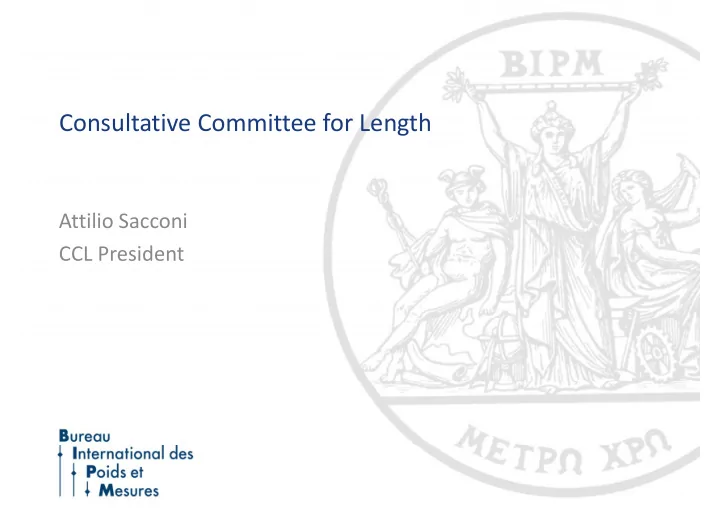

Consultative Committee for Length Attilio Sacconi CCL President
Main metrological areas km Geodetic ‐ scale metrology (100s of metres) Large volume metrology (1 metre to 10s of metres) Coordinate metrology (3D) (~1 mm to ~2 m) Realization of the metre definition (UV to IR wavelengths) m, ° Angle metrology (sub arc second to n ×360°) Classical optical metrology (nm flatness, 10 m RoC) Surface metrology (form, roughness) (1 nm to ~500 mm) Micro ‐ metrology (~50 µm to 250 mm, 3D) Dimensional nanometrology (10 pm to 100 nm, 1D or 2D) pm 2
Areas of priority Keeping the MeP updated and relevant Support the growing use/introduction of combs Provide validation means for wavelength standards Dimensional nanometrology TEM traceability via lattice parameters Methods divergence (linewidth by: AFM, SEM, optical) Hybrid or multi ‐ sensor metrology (model ‐ based) Comparisons (nanogratings, step height, nanoparticles) Coordinate and surface metrology Non ‐ contact, e.g. optical scanners, fringe projection X ‐ ray Computed Tomography Traceability & accuracy of optical techniques Shop ‐ floor metrology In process, in situ , local traceability www.bipm.org 3
Stakeholder involvement MacroScale and NanoScale conference series Stakeholder presentations at these conferences (from e.g . equipment manufacturers, some end users) National programmes prioritisation Local needs are best collected here Inter ‐ NMI research Programmes, e.g. EMRP/EMPIR Confirmed needs set the R&D programme agenda Individual projects have stakeholder committees End of project workshop for stakeholders – future scan activity Stakeholders take part (unfunded) as they can see a benefit Accreditors and regulators During re ‐ assessment or direct feedback to NMI/DI Customers and partners Users of calibration services provide feedback NMIs as partners in research projects with industry www.bipm.org 4
Inter ‐ disciplinary issues Thermal Expansion Some email interactions between CCL and CCT on CTE standards – current issues have been solved Nanometrology Discussed at BIPM Nanometrology workshop in Feb. 2010: ‐ outcome: no urgent need for joint CC on Nanometrology Discussion paper on traceability via Si ‐ lattice prepared by WG ‐ N Using MEMS/nanoscale devices for dimensional metrology WGFS – CCL & CCTF (frequency vs . wavelength) Optical frequency list – ongoing developments Software in metrology Reference data sets, and algorithms Testing/validating commercial & ‘open’ software www.bipm.org 5
Future strategy Ongoing research into metre realization Frequency standards and artefacts for nanometrology, distributed standards e.g. GPS, fiber nets etc . Coordinate and surface metrology – new techniques Multi ‐ sensor (tactile, optical, X ‐ ray CT) coordinate metrology Micro coordinate metrology for micro parts Metrology of functional structured surfaces (areal surface texture) Intrinsically traceable metrology (in situ realisation) High dynamic range (10 µm defect in 100 cm 2 @ 20 m min ‐ 1 ) Metrology of large engineering structures & geodesy Long distance interferometry and ranging (fs comb applications) GNSS verification 3D refractive index over larger volumes Metrology at the nanoscale Metrology of complex 3D nanostructures and nanoparticles High resolution interferometry at sub ‐ nanometre accuracy Nanometre accuracy over several 100 mm range (position, form, ...) www.bipm.org 6
Recommend
More recommend